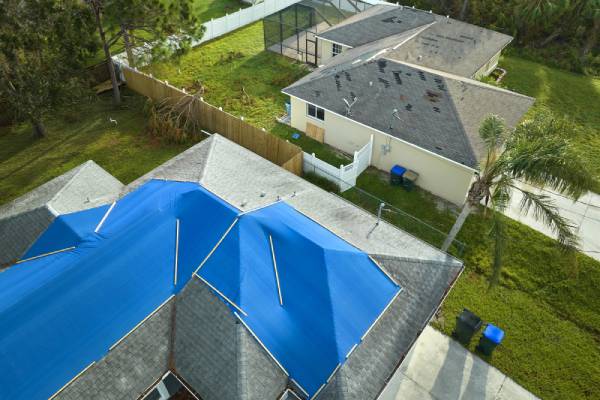While hurricanes and severe storms aren’t regular visitors to Southwest Minnesota, the occasional extreme weather can pack a serious punch. From powerful winds to driving rain and flying debris, your roof is your home’s first line of defense. But is it truly up to the task?
Protecting your home starts with knowing how to fortify your roof against these challenges. By tapping into expert advice from seasoned local roofing contractors for hurricane roof protection, you can minimize risks and enhance your home’s resilience.
Assessing Your Roof’s Vulnerability
Evaluate your roof’s current condition before making improvements. A weak roof is more susceptible to damage during storms. Factors like loose shingles, deteriorating flashing, or inadequate sealing around vents can become significant issues when high winds hit.
Begin with a professional inspection. Local roofing contractors in Minnesota recommend examining the integrity of shingles, underlayment, and structural elements. Cracks, leaks, or loose components should be repaired promptly. This proactive approach can prevent minor issues from escalating into costly repairs after a storm.
Reinforcing Shingles and Roof Components
High winds can rip shingles from roofs, leaving underlying materials exposed to rain and debris. Installing wind-resistant shingles is a key step in hurricane roof protection. Many shingles on the market today are rated to withstand wind speeds of 110 to 150 miles per hour. Asphalt shingles with adhesive strips create a tighter seal, offering additional protection.
In addition to shingles, reinforce other vulnerable components like flashing, vents, and ridge caps. Quality flashing helps prevent water infiltration at roof edges and around protrusions. Contractors recommend heavy-duty flashing materials and proper sealing to withstand strong winds and heavy rainfall.
Roof Decking and Fasteners: The Foundation of Protection
Your roof’s decking—the layer beneath the shingles—plays a critical role in its ability to endure storms. Damaged or weak decking can compromise the entire roof structure. Consider installing thicker plywood or OSB (oriented strand board) decking to enhance wind resistance.
Fasteners also impact your roof’s stability. Roofing nails and screws should penetrate deeply into the decking to secure shingles and underlayment. Contractors recommend ring-shank nails, which offer better holding power compared to traditional smooth-shank nails. Adding more fasteners in critical areas like eaves and edges further increases wind resistance.
Installing a Secondary Water Barrier
A secondary water barrier is a layer of protection designed to prevent water intrusion and safeguard your home during extreme weather. This barrier is installed beneath the shingles and serves as a failsafe, preventing leaks even if the top roofing layer is damaged. Synthetic underlayment can resist tearing and provide excellent waterproofing, whereas peel-and-stick membranes adhere directly to the roof decking and create a tight, reliable seal.
Roofing contractors in Minnesota recommend using a secondary water barrier in vulnerable areas like roof valleys, edges, and around penetrations such as chimneys or vents. These areas are more prone to leaks during heavy rain or snowmelt. This layer also adds an extra line of defense against ice dams, a common problem in cold climates. By preventing water infiltration in these critical spots, secondary barriers protect your home’s structural integrity and reduce the likelihood of costly interior repairs.
Impact-resistant Roofing Materials
Flying debris is one of the most destructive elements during storms. Investing in impact-resistant materials can save your roof from extensive damage. Class 4 impact-resistant shingles are designed to withstand hail and debris without cracking or breaking. These shingles are tested to endure high-impact strikes, offering superior durability compared to standard options.
Metal roofing is another excellent choice for hurricane roof protection. Its smooth surface allows debris to slide off more easily, and its durability makes it resistant to wind and impact damage. Metal roofs are also lightweight, reducing the stress on your home’s structure.
Roof Vent and Gutter Protection
Unprotected vents and gutters can become weak points during storms. High winds can dislodge loose vents, creating openings for water to enter your home. Securing vents with hurricane straps or clips helps prevent these issues. Contractors may also recommend installing vent covers or upgrading to wind-resistant designs.
Similarly, gutters should be reinforced and cleared of debris for proper drainage during heavy rainfall. Seamless gutters and sturdy brackets can withstand high winds better than sectional systems. Adding gutter guards prevents clogs, reducing the likelihood of water pooling around your foundation.
Chimney and Skylight Considerations for a Stronger Roof
Chimneys and skylights are beautiful and functional additions to any home, but they can also be weak points in your roof’s structure if not properly maintained. Flashing around chimneys and skylights is often the first line of defense against water infiltration. Over time, flashing can deteriorate due to exposure to extreme weather, leading to leaks and water damage. Upgrading to high-quality metal flashing or applying a waterproof sealant can prevent these issues.
For skylights, choosing impact-resistant glass and proper insulation helps protect against hailstorms and heat loss during winter. Routine inspections of the seals and surrounding shingles will catch potential problems early, saving you from costly repairs down the road.
Hurricane Straps and Roof Tie-Downs
Hurricane straps and roof tie-downs help anchor your roof to your home’s walls. These metal connectors secure the roof trusses or rafters to the structure, minimizing the risk of uplift during strong winds. While these reinforcements are more common in hurricane-prone regions, they offer valuable protection for homes in Minnesota’s storm-prone areas as well.
Contractors can retrofit existing roofs with hurricane straps or install them during new roof construction. This added layer of security strengthens the connection between the roof and the walls, significantly reducing storm damage risks.
Pre-Storm Preparation Tips
Preparing your roof before a storm strikes is just as important as making structural improvements. Here are some tips to follow:
- Schedule a professional roof inspection to identify weak spots.
- Clear debris from your roof, gutters, and downspouts.
- Trim overhanging branches to prevent them from falling on your roof.
- Secure outdoor furniture and other items that could become airborne.
- Check your attic for signs of leaks or moisture, addressing issues before the storm.
Taking these steps helps reduce the likelihood of storm-related damage and increases your roof’s ability to withstand severe weather.
Insurance and Warranty Considerations
Storm damage can be expensive, so understanding your insurance policy and roofing warranty is vital. Review your homeowner’s insurance to confirm coverage for wind and hail damage. Some policies may require additional riders for specific storm events, so clarify these details with your insurer.
Many roofing warranties include clauses about storm damage. Some cover repairs or replacements due to wind and impact damage, while others exclude storm-related issues. Keep all warranty documentation and repair records, as these may be needed for insurance claims or warranty coverage.
Harvey’s Five Star Roofing: Impact-resistant Roofing for Southwest Minnesota Homes
Protecting your roof from severe storms and occasional extreme weather in Southwest Minnesota starts with expert care and planning. At Harvey’s Five Star Roofing, we specialize in durable, storm-ready roofing solutions, from impact-resistant materials to expertly installed reinforcements like hurricane straps and secondary water barriers.
Whether you need a professional inspection, upgrades to vulnerable components like flashing and skylights, or a full roof replacement, our experienced team is here to help. With over 25 years of experience, we’re proud to provide top-quality service backed by our Five Star Warranty.
We offer free inspections and estimates, so you can make informed decisions about your roof’s protection without any upfront commitment. Don’t wait until the next storm hits—call us at (712) 832-3660 or get a quote online today. Let us safeguard your home and give you peace of mind for years to come.









